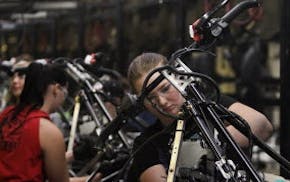Minnesota is one of the fastest-warming states in the country and, measured by rising winter temperatures, Minneapolis and Mankato are among the three fastest-warming cities, a team of scientists told state lawmakers Tuesday.
Climate change means the state will be buffeted by more supercharged weather — heat waves, droughts, deluges, wind storms, flooding and even wildfires. But for Minnesota, it's primarily a winter phenomenon. The state's famous winters are warming 13 times faster than its summers, said Tracy Twine, an associate professor in the University of Minnesota's Department of Soil, Water and Climate.
"We just don't expect temperatures to be below 10 degrees Fahrenheit in Duluth anymore," Twine said.
Tuesday's committee hearing was the first of several by the newly named House Energy and Climate Finance and Policy Division, which plans to spotlight climate change as it expands its jurisdiction. Hearings on Thursday and next Tuesday will focus on how climate change is affecting human health and the sources of greenhouse gas emissions.
With the hearings, the committee hopes to signal that Minnesota lawmakers must "move much faster than we have before," Committee Chairwoman Jean Wagenius, DFL-Minneapolis, said in an interview.
J. Drake Hamilton, science policy director for Fresh Energy, an environmental nonprofit, attended the hearing and applauded the committee's new focus. "This is the first time that 'climate' has ever been in the title of any committee here," she said. "This is really good news."
Exactly how the loss of cold extremes will play out across Minnesota's varied landscapes isn't quite clear yet, the researchers said, although they expect to see more freeze-thaw cycles each winter, with cold-loving species of plants and animals shifting north. The state, which is extremely sensitive to climate change, is warming more in the north than the south, with cities warming faster than the rest of the landscape, the witnesses said.
"It can't be overstated that for every incremental change we look at in the global record of the global model … the research shows that it translates into a very highly amplified change in our Minnesota backyard," said retired University of Minnesota meteorologist Mark Seeley. "That can't be overstated."
Cutting emissions such as carbon dioxide is possible and necessary, the witnesses said. Twine pointed to the success of public policy starting in the 1980s in reducing chlorofluorocarbons to help repair the ozone layer in the earth's atmosphere.
Twine and Peter Reich, a professor in U's Department of Forest Resources, showed the committee a series of charts and graphs detailing the dramatic loss of cold extremes across a state that will get warmer and wetter, and suffer greater swings in weather.
For example, Minnesota will get more precipitation, yet experience warmer, drier conditions in late summer, including the potential for August "dry-outs" that would crisp plants. Parts of the state — a band through the state's upper middle, and its southeastern corner — could see average August rainfall drop by up to 60 percent by the end of the century, according to Twine.
In the Twin Cities, August rainfall is forecast to decrease by an estimated 35 percent. That will affect yards, gardens, pastures and fields.
No loons?
Farmers may enjoy some higher crop yields in the short run, Reich said. But long term, crop yields will decline with higher temperatures. They will also be affected by an increase in pests and insects that were once restricted by cold winters.
Asian soybean rust, a threat to one of Minnesota's largest cash crops, is spreading and might eventually be able to survive in the state's warmer winter, Seeley told the group.
"It is not out of the realm of possibility that we will see the disease in Minnesota in some prolific way that we will have to treat," he said. "That's just a small example of all the organisms that we might not be able to anticipate." Forestry researchers at the U have also projected that Minnesota's tree population will change as its pine woods retreat north.
There was an audible murmur in the room when a committee member noted that the National Audubon Society has said warming winters would chase out Minnesota's state bird, the common loon.
"The sense of urgency," said Rep. Laurie Halverson, DFL-Eagan, "is pretty stark for our state."
Jennifer Bjorhus • 612-673-4683

Minnesota added thousands of jobs in March but worker shortage still an issue
Private prison van driver, accused of raping St. Paul woman he was transporting, gets 30 years for similar attacks

Shop the curbs for free on 'Trash to Treasure Day' in White Bear Lake
Longtime Uptown boutique closing in May

